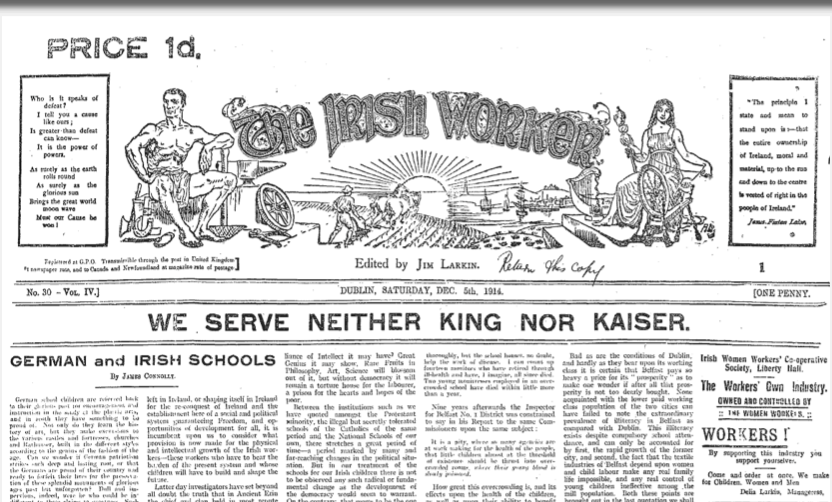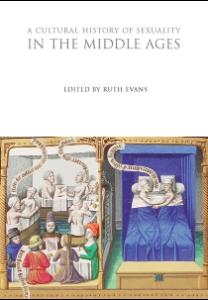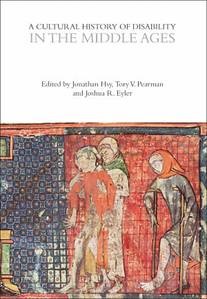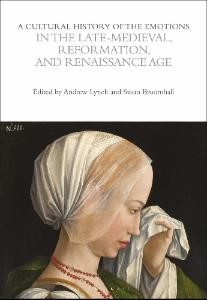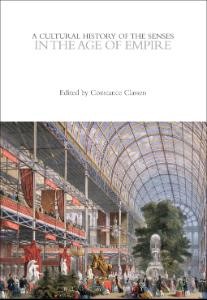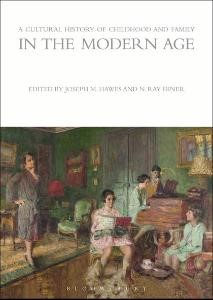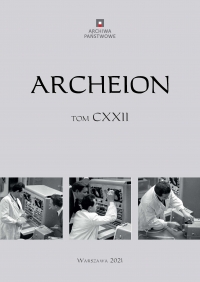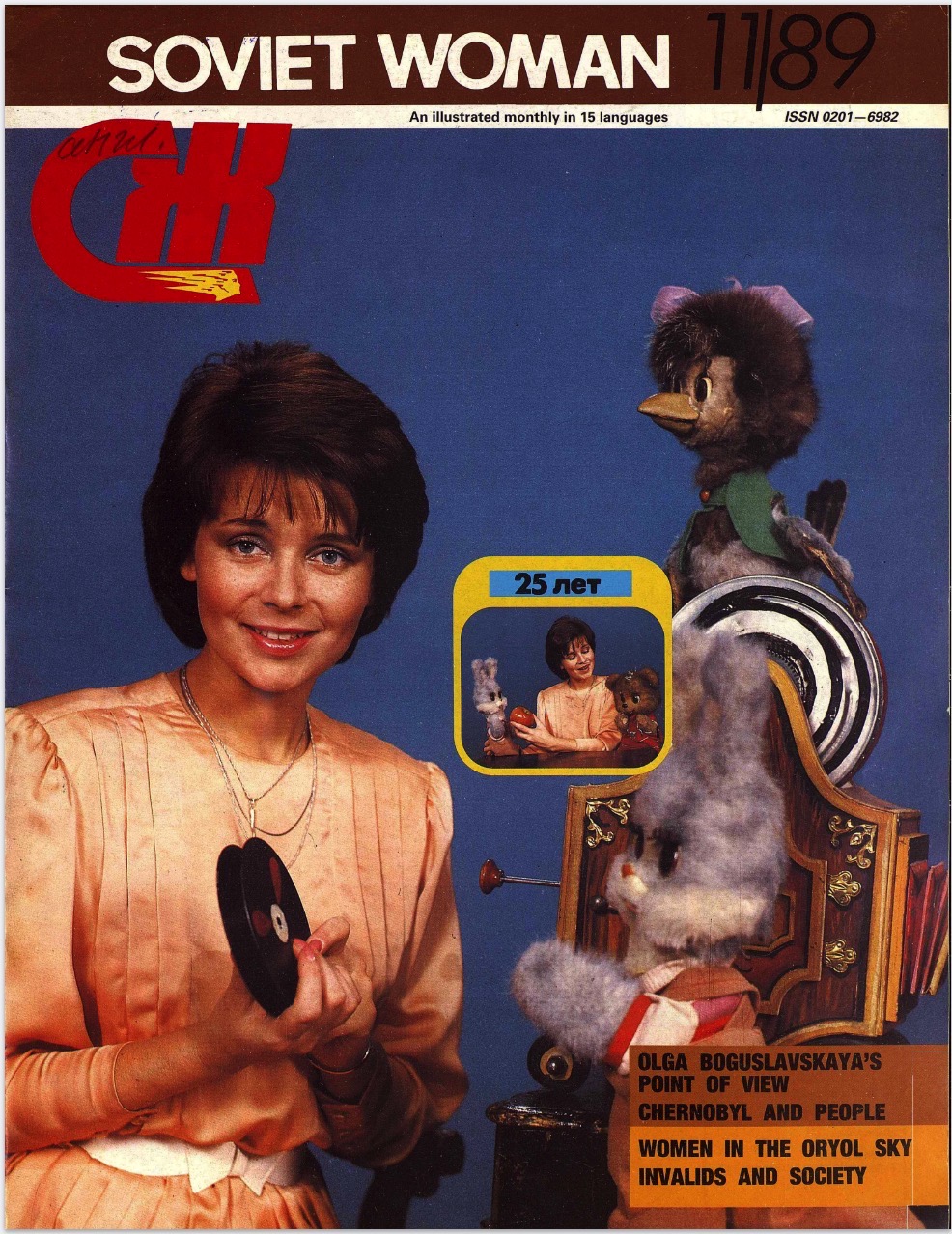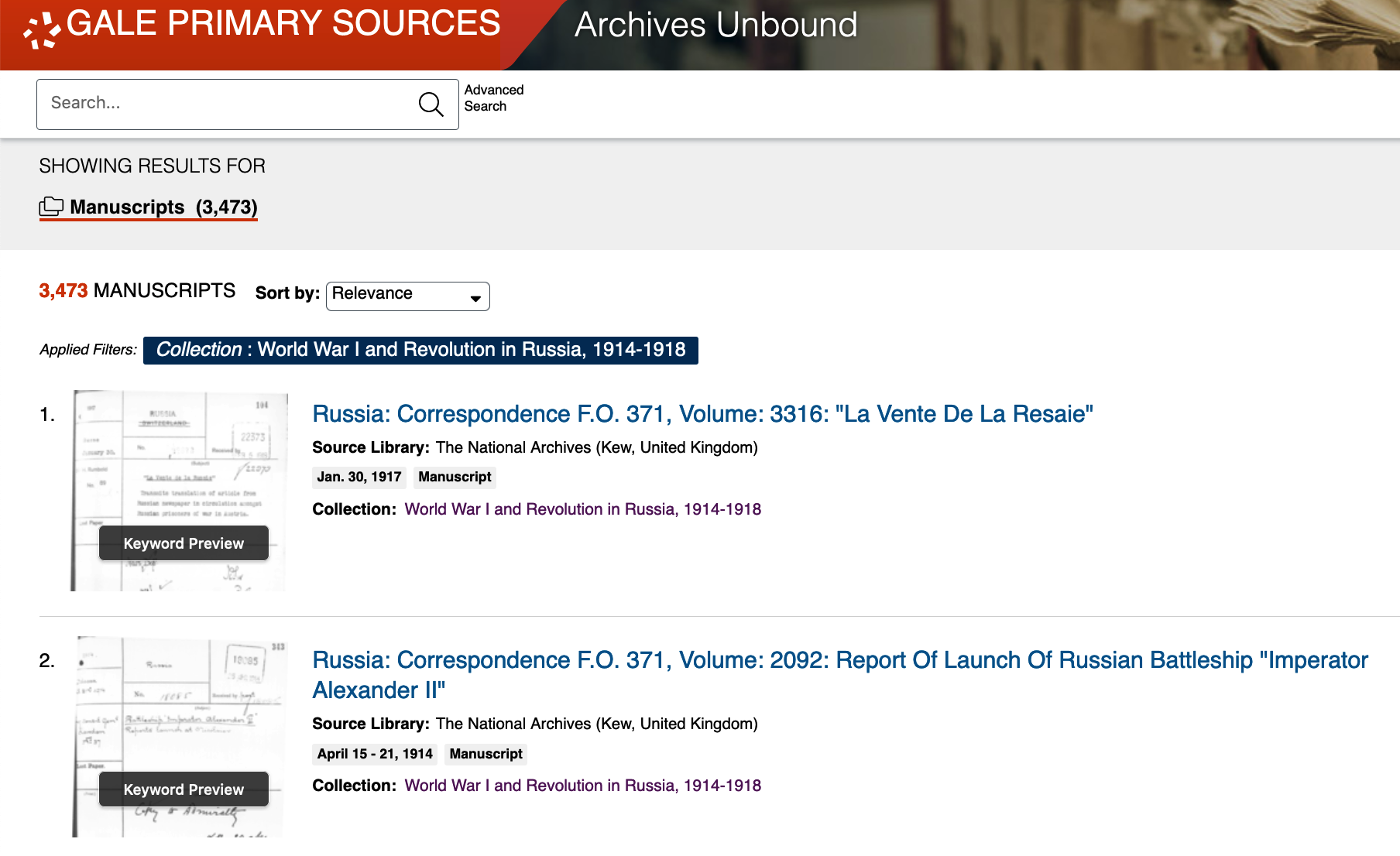In line with the Bodleian Libraries’ strategy to enhance our collections, we committed substantial funding to a set of purchases of electronic research resources deemed to be important to researchers in the University.
I am therefore delighted to announce access to the following new eresources which are of interest to Oxford historians. They will be most relevant to early modern, modern and global historians. Usage of some of these resources will be reviewed in the course of the next 3 years to assess which will be permanently retained.
All databases can be found in SOLO and Databases A-Z. Oxford researchers should use SSO to gain remote access. Non-Oxford historians are welcome to register with Bodleian Libraries to gain access to these resources and many others.
New online newspaper and magazine resources: British & US

Screenshot of the landing page.
The Independent Historical Archive 1986-2016: Ever since it was launched in 1986, The Independent has enjoyed a reputation for quality and innovation, something Andreas Whittam-Smith and his two co-founders, Stephen Glover and Matthew Symonds, made as a guiding principle when they conceived the idea of a new, upmarket British newspaper.
International Herald Tribune Historical Archive, 1888-2013: Sold in over 160 countries and read worldwide, the International Herald Tribune is one of the most innovative and original newspapers, famous for its objective and clear coverage. Bringing an international perspective, it provides a valuable counterpoint to the Anglo-American press, adding a new dimension to research. This resource features the complete run of the International Herald Tribune from its origins as the European Edition of The New York Herald and later the European Edition of the New York Herald Tribune. The archive ends with the last issue of the International Herald Tribune before its relaunch as the International New York Times.
The Jet Magazine Archive: Covers the civil rights movement, politics, education, and other social topics with an African American focus. It includes over 3,000 issues providing a broad view of news, culture, and entertainment from its first issue in 1951 through to 2014. Users can search across the articles using full-text search, or select specific issues, years or themes. Each article is indexed with relevant keywords. Researchers can also view images and advertisements within each issue. Current coverage covers in the 1980s decade, with additional issues being released over the next coming months.
The Listener Historical Archive, 1929-1991: A weekly magazine which was established by the BBC in 1929 under its director-general, Lord Reith. It was developed as the medium for reproducing broadcast talks, initially on radio, but in later years television as well, and was the intellectual counterpart to the BBC listings magazine Radio Times. The Listener is one of the few records and means of accessing the content of many early broadcasts. In addition to commenting on the intellectual broadcasts of the week, the Listener also previewed major literary and musical shows and regularly reviewed new books.
Picture Post Historical Archive, 1938-1957: The Picture Post Historical Archive comprises the complete archive of the Picture Post from its first issue in 1938 to its last in 1957—all digitized from originals in full colour.
Picture Post’s innovative use of photo-journalism captured the imagination of the British people, with readership at its peak estimated at 80% of the population. In the era before television, it became the window on the world for ordinary people, bringing the major social and political issues of the day into popular consciousness.
Punch Historical Archive, 1841-1992: From 1841 to 1992, Punch was the world’s most celebrated magazine of wit and satire. From its early years as a campaigner for social justice to its transformation into national icon, Punch played a central role in the formation of British identity—and how the rest of the world saw the British nation.
We have also purchased access to additional years of newspaper content for the following:
New online newspaper resources: global

Screenshot of the landing page
Afghan Central Press Digital Archive: The Afghan Central Press collection brings together four national, Kabul-based publications of Afghanistan whose long runs and prominence provide a concentrated vantage point for understanding developments in Afghanistan for much of the twentieth century. The English-language Kabul Times is presented alongside Pushto publications Anīs (انیس, Companion), Hewād (هیواد, Homeland), and Iṣlāḥ (اصلاح, Reform). Together, the archives of these newspapers provide a chronicle of events from the fall of the Kingdom of Afghanistan, the establishment of the People’s Democratic Republic of Afghanistan, the Soviet invasion, the rise of the Mujahedeen, the establishment of the Taliban and Al Qaeda, invasion by the United States and the ensuing period of reconstruction from the view of the capital.
Al-Ahram Digital Archive (1875-2020): Founded in 1875, Al-Ahram (الأهرام) is one of the most prominent Arabic newspapers in the Middle East, with a legacy as Egypt’s most authoritative and influential national daily. Al-Ahram established itself as a high-quality journalistic venture during the mid-20th century reporting across the political, social, economic and cultural scope of the nation. After President Nasser nationalized the Egyptian press in 1960, readers generally considered the paper the de facto voice of the central government. Al-Ahram has long featured contributions from many of the Arab world’s most important literary figures and intellectuals: Naguib Mahfouz, Edward Said, Yusuf Idris, Taha Hussein, Ahmed Lutfi el-Sayed, and Azmi Bishara among them, as well as nationalist leaders such as Mustafa Kamil and Saad Zaghlul. Influential forward-leaning contemporary writers such as Sabah Hamamou are also affiliated with the paper. The newspaper over its history successfully expanded to circulate content from around the world, printing international editions as well as Arabic-language editions of the daily. The Al-Ahram Digital Archive features full page-level digitization, with page-views and searchable text. It offers scholars Arabic and English interfaces, options to download or print pages in high resolution, and features to crowd-source improvements to the OCRed text.
Caribbean Newspapers, Series 1, 1718-1876: Created in cooperation with the American Antiquarian Society, this collection gives scholars access to more than 150 years of Caribbean and Atlantic history, cultures and daily life. Featuring more than 140 newspapers from 22 islands, it chronicles the region’s evolution across two centuries through eyewitness reporting, editorials, legislative information, letters, poetry, advertisements, obituaries and other news items. Most titles are in English but a number of Spanish, French, and Danish language titles are also provided. Also included are newspapers from the North Atlantic island of Bermuda.
Cumhuriyet Digital Archive (1924-2020): Established in May 1924, Cumhuriyet (“The Republic”) is the oldest secular Turkish daily newspaper and is widely considered one of the last remaining opposition newspapers in Turkey. Founded by journalist Yunus Nadi Abalıoğlu at the initiative of Mustafa Kemal Atatürk, Cumhuriyet was the first newspaper of the Turkish Republic and promoted a belief in democracy, secularism and the rule of law.
Since its foundation, Cumhuriyet has stood witness to the changing landscape of Turkey’s political, social and economic environment. Despite the challenges of these times, the institution of Cumhuriyet has sustained its coverage of domestic and international news, providing critical documentation of Turkey’s dynamic history and its relations with the global community. The newspaper has a daily circulation of over 30,000 and receives roughly 25 million visitors to its website each month. It is one of the most influential newspapers in Turkey and is regarded by domestic and foreign readers as a reliable source for impartial, intelligent news reporting.
Latin American Newspapers, Series 2 (1805-1922): This second series of digitised Latin American Newspapers significantly expands the number of searchable titles made available from this region in Series 1. It provides issues from more than 250 additional titles and contains newspapers published in English, Spanish and Portuguese from 20 countries, including some countries and cities not represented in the first series. Together, both series offer unprecedented coverage of the people, issues and events that shaped this vital area during the 19th and early 20th centuries. [Through eyewitness reporting, editorials, legislative information, letters, poetry, advertisements, matrimony notices and obituaries, this unique collection chronicles the evolution of Latin American culture and daily life across two centuries. In addition, these newspapers provide a wide range of viewpoints from diverse cultures.]
Kavkaz Digital Archive (DA-KVZ): ‘The newspaper Kavkaz (Кавказ, The Caucasus) was published during 1846-1918. It was the first Russian-language newspaper in the Caucasus, published in Tiflis (Tbilisi), Georgia. The main purpose of the newspaper was, on the one hand, to promote the Russian culture and Russian influence in the Caucasus, and on the other hand “to acquaint the Russian public with the life, habits and traditions of the tribes populating the province of the Caucasus.” Kavkaz published official documents of the Russian Empire, as well as many historical, cultural and archeological writings by prominent public and cultural figures of the local intelligentsia.’
Kavkaz Digital Archive is available on the Universal Database (UDB) platform and the Global Press Archive (GPA) platform; they provide a slightly different viewing experience but include the same content.
Middle Eastern and North African Newspapers Premium Collection (CRL-WIDE1): The MENA Premium collection package complements the freely available Middle Eastern and North African Newspapers Open Access collection. Comprising five prominent in-copyright newspapers from across the region, the MENA Premium collection spans the period of 1956-2019 and represents a collaboration between East View and the publishers of each title to make current, in-copyright material available to a global audience. MENA Premium Collection Titles include al-Akhbār (االخبار ,Lebanon, 2006-2019), al-Dustūr (الدستور ,Jordan, 1967-2000), al-Jumhūrīyah (الجمهورية ,Egypt, 1962-1986), al-Riyāḍ (الرياض ,Saudi Arabia, 1972-1996) and Filasṭīn (فلسطين , Israel/Palestine, 1956-1967).
Tip: To learn more about our newspaper eresources and how best to locate and find them, check out the Newspapers and other online news sources from the 17th – 21st centuries (LibGuide)
Modern British and US history
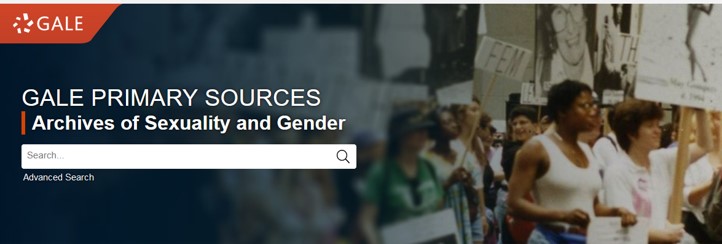
Screenshot of landing page
Archives of Sexuality and Gender, part I: LGBTQ History and Culture since 1940 This resource spans the sixteenth to twentieth centuries and is the largest digital collection of historical primary source publications relating to the history and study of sex, sexuality, and gender research and gender studies research. Documentation covering disciplines such as social, political, health, and legal issues impacting LGBTQ (lesbian, gay, bisexual, transgender, queer) communities around the world are included, as well as rare and unique books on sex and sexuality from the sciences to the humanities to support research and education. Oxford only has access to part I.
Nineteenth Century Collections Online: British Politics and Society: The British Politics and Society archive of Nineteenth Century Collections Online (NCCO) is packed with primary source documentation that enhances a greater understanding and analysis of the development of urban centers and of the major restructuring of society that took place during the Industrial Revolution. The archive is composed of a number of individual collections, drawn together from a variety of sources.
Foreign Office Files for Japan: Module II: Occupation of Japan, 1946-1952: Published in three parts, this collection makes available extensive coverage of British Foreign Office files dealing with Japan between 1919 and 1952, shedding light on Anglo-Japanese ties in a time of shifting alliances. This second module covers the Occupation period (1946-1952). Following surrender at the end of the Second World War, Japan was occupied by Allied Powers for the first time in its history. The files for this period offer a British perspective on the creation of a democratic state in Japan and the enforcement of a new constitution. They include key British communications and reports covering topics such as war crime trials, reparations, and Japan’s economic recovery. They conclude in 1952, the year the Treaty of San Francisco normalised Anglo-Japanese relations and the first post-war British Ambassador to Japan, Esler Dening, was appointed. The majority of documents in this section are sourced from FO 371, with a smaller number from FO 262.
Topics covered include: disarmament, war crime trials, Japanese economy, trade and industry, occupational forces, liberation and the New Constitution, Japanese Post-War Political Parties, Peace Treaty and reestablishing diplomatic ties.
Global history
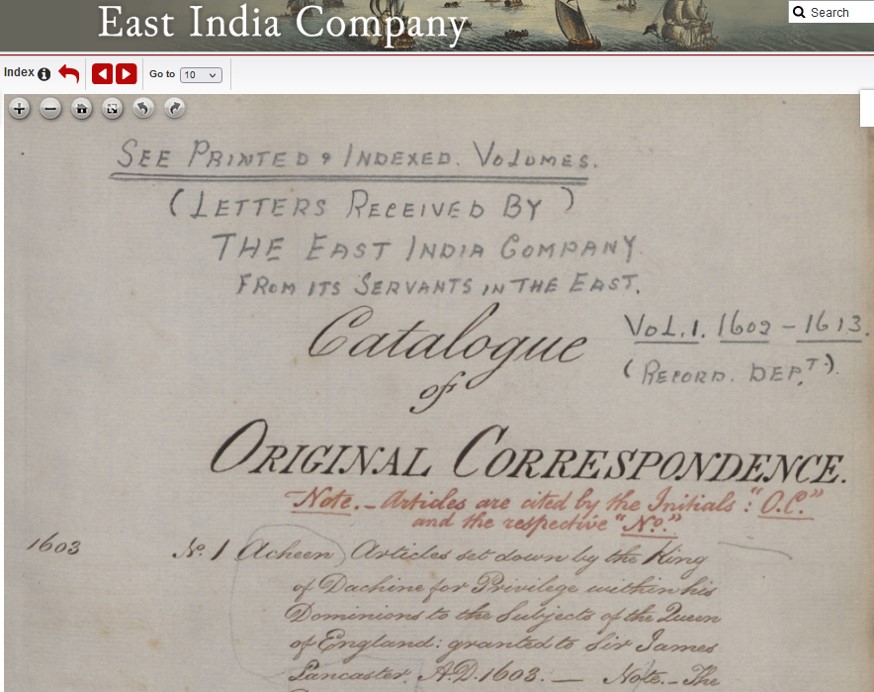
Screenshot of page 1, East India Company Catalogue of Original Correspondence, vol 1, 1602-1613, Adam Matthew Digital.
Cambridge Archive Editions Online: presents a wealth of historical reference materials in the form of many thousands of original documents of the National Archives (UK) represented in facsimile, including numerous maps, on the national heritage and political development of many countries. The value and discoverability of this content is enhanced immeasurably through CAE’s document-level citations and rich indexing. For many years CAE has specialized in the history of the Middle East, Russia and the Balkans, the Caucasus, Southeast Asia, and China and the Far East. Now, through collaboration between Cambridge University Press and East View, these materials are made searchable and accessible in e-book form.
Includes China Political Reports, 1911-1960 and China Political Reports, 1961-1970, which draw together the periodic political reports sent by British officials based in China back to the British Foreign Office.
Chatham House Online Archive: Module 1: Publications and Archives of the Royal Institute of International Affairs, 1920-1979 (see above)
Database of Chinese Classics 中國基本古籍庫 (Erudition): includes 10,000 titles in 12,500 editions from the pre-Qin period through to the Republican period. All texts are provided in full text and image format, allowing for a direct comparison both between digitized text and original text image, and in some cases between different editions of the text. The full-text and images from a variety of subject areas organized into four sections: Philosophy and Science, History and Geography, Art and Literature, and General Works.
Early Arabic Printed Books from the British Library: Literature, Grammar, Language, Catalogues, and Periodicals: Early Arabic Printed Books from the British Library (1475-1900) is the first full-text searchable digital library of early printed books in Arabic script. It is presented in 3 modules with this module (number 3) including periodicals, folktales, pre-Islamic literature (Antar, Bani Hilal, Imru’l qays), Islamic poetry and prose (al-Burdah), poetry and prose (maqamat), Kalilah wa-dimnah, Luqman, proverbs and sayings, Thousand and one nights, later literature, poetry and prose, general literature, as well as language and lexicography, dictionaries, grammar, syntax, rhetoric, ‘ilm al-bayan, catalogues and manuscript catalogues amongst others.
East India Company Part IV which covers the correspondence of the early voyages and formation and conflictbetween 1600 and 1858. This module consists of 793 volumes, comprising original, draft and abstracted correspondence from IOR Class E plus their associated H- and Z-class indexes, and the Z-class indexes for the Madras and Bombay Presidencies.
It includes correspondence between the East India Company and the Board of Commissioners for the Affairs of India, the Company’s various settlements and Presidencies throughout Asia, government departments, and European houses of agency. The records offer a fascinating insight into the early voyages of the Company and its shifting interests from trade to the gaining of territorial power, and are interspersed with a number of petitions, reports (including quarterly ‘Narratives of Proceedings’ produced by regional administrations), financial accounts, inventories and other documents.
Oxford now has East India Company (Modules I-IV).
Foreign Office Files for Japan: Module II: Occupation of Japan, 1946-1952: (see above)
Grand Secretariat Archives: The archives of the Grand Secretariat currently housed at the Institute were originally kept at the Grand Secretariat Storehouse in the Ch’ing imperial palace. They were removed from the Storehouse when it underwent renovation in 1909. After the overthrow of the Ch’ing, these archives changed hands several times, and were, at one point, even sold to a paper recycling factory. Eventually, the Institute purchased them from Li Sheng-to, a book collector, in1929 thanks to the efforts of Fu Ssu-nien, the Institute’s first director.
There are over four thousand Ming (1368-1644) documents and more than three hundred thousand volumes of Ch’ing (1644-1911) archival materials in this collection, including imperial decrees, edicts, memorials, tribute document, examination questions, examination papers, rosters of successful examination candidates, documents from the offices of the Grand Secretariat, documents from the offices for book compilation, and old documents from Mukden. Memorials make up the bulk these documents.
The archives contain valuable source materials for institutional, social and economic historians. They record general administrative activities and legal cases, many of which cannot be found in Ch’ing legal compendia.
Related links:
 Great news! Wiley is making the The Royal College of Physicians – Part I (Wiley Digital Archives) available to Jisc members in perpetuity as a gesture of thanks for participating in the Wiley transitional agreement in 2022. History of medicine researchers can now benefit from access to this resource.
Great news! Wiley is making the The Royal College of Physicians – Part I (Wiley Digital Archives) available to Jisc members in perpetuity as a gesture of thanks for participating in the Wiley transitional agreement in 2022. History of medicine researchers can now benefit from access to this resource.
